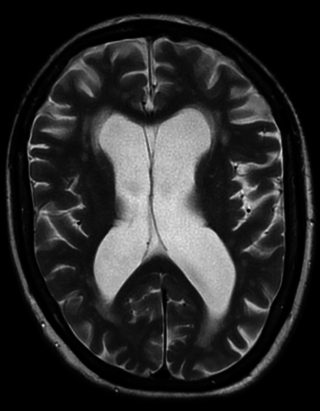
Dementia is a syndrome associated with many neurodegenerative diseases, characterized by a general decline in cognitive abilities that affects a person's ability to perform everyday activities. This typically involves problems with memory, thinking, behavior, and motor control. Aside from memory impairment and a disruption in thought patterns, the most common symptoms of dementia include emotional problems, difficulties with language, and decreased motivation. The symptoms may be described as occurring in a continuum over several stages. Dementia ultimately has a significant effect on the individual, their caregivers, and their social relationships in general. A diagnosis of dementia requires the observation of a change from a person's usual mental functioning and a greater cognitive decline than might be caused by the normal aging process.

Aster is a genus of perennial flowering plants in the family Asteraceae. Its circumscription has been narrowed, and it now encompasses around 170 species, all but one of which are restricted to Eurasia; many species formerly in Aster are now in other genera of the tribe Astereae. Aster amellus is the type species of the genus and the family Asteraceae.

Vascular dementia is dementia caused by a series of strokes. Restricted blood flow due to strokes reduces oxygen and glucose delivery to the brain, causing cell injury and neurological deficits in the affected region. Subtypes of vascular dementia include subcortical vascular dementia, multi-infarct dementia, stroke-related dementia, and mixed dementia.

Frontotemporal dementia (FTD), also called frontotemporal degeneration disease or frontotemporal neurocognitive disorder, encompasses several types of dementia involving the progressive degeneration of the brain's frontal and temporal lobes. Men and women appear to be equally affected. FTD generally presents as a behavioral or language disorder with gradual onset. Signs and symptoms tend to appear in late adulthood, typically between the ages of 45 and 65, although it can affect people younger or older than this. Currently, no cure or approved symptomatic treatment for FTD exists, although some off-label drugs and behavioral methods are prescribed.

Donepezil, sold under the brand name Aricept among others, is a medication used to treat dementia of the Alzheimer's type. It appears to result in a small benefit in mental function and ability to function. Use, however, has not been shown to change the progression of the disease. Treatment should be stopped if no benefit is seen. It is taken by mouth or via a transdermal patch.

Galantamine is a type of acetylcholinesterase inhibitor. It is an alkaloid extracted from the bulbs and flowers of Galanthus nivalis, Galanthus caucasicus, Galanthus woronowii, and other members of the family Amaryllidaceae, such as Narcissus (daffodil), Leucojum aestivum (snowflake), and Lycoris including Lycoris radiata. It can also be produced synthetically.
Cognitive reserve is the mind's and brain's resistance to damage of the brain. The mind's resilience is evaluated behaviorally, whereas the neuropathological damage is evaluated histologically, although damage may be estimated using blood-based markers and imaging methods. There are two models that can be used when exploring the concept of "reserve": brain reserve and cognitive reserve. These terms, albeit often used interchangeably in the literature, provide a useful way of discussing the models. Using a computer analogy, brain reserve can be seen as hardware and cognitive reserve as software. All these factors are currently believed to contribute to global reserve. Cognitive reserve is commonly used to refer to both brain and cognitive reserves in the literature.
Cognitive impairment is an inclusive term to describe any characteristic that acts as a barrier to the cognition process or different areas of cognition. Cognition, also known as cognitive function, refers to the mental processes of how a person gains knowledge, uses existing knowledge, and understands things that are happening around them using their thoughts and senses. Cognitive impairment can be in different domains or aspects of a person's cognitive function including memory, attention span, planning, reasoning, decision-making, language, executive functioning, and visuospatial functioning. The term cognitive impairment covers many different diseases and conditions and may also be symptom or manifestation of a different underlying condition. Examples include impairments in overall intelligence, specific and restricted impairments in cognitive abilities, neuropsychological impairments, or it may describe drug-induced impairment in cognition and memory. Cognitive impairments may be short-term, progressive, or permanent.

Anemone hepatica, the common hepatica, liverwort, liverleaf, kidneywort, or pennywort, is a species of flowering plant in the buttercup family Ranunculaceae, native to woodland in temperate regions of the Northern Hemisphere. This herbaceous perennial grows from a rhizome.
The prevention of dementia involves reducing the number of risk factors for the development of dementia, and is a global health priority needing a global response. Initiatives include the establishment of the International Research Network on Dementia Prevention (IRNDP) which aims to link researchers in this field globally, and the establishment of the Global Dementia Observatory a web-based data knowledge and exchange platform, which will collate and disseminate key dementia data from members states. Although there is no cure for dementia, it is well established that modifiable risk factors influence both the likelihood of developing dementia and the age at which it is developed. Dementia can be prevented by reducing the risk factors for vascular disease such as diabetes, high blood pressure, obesity, smoking, physical inactivity and depression. A study concluded that more than a third of dementia cases are theoretically preventable. Among older adults both an unfavorable lifestyle and high genetic risk are independently associated with higher dementia risk. A favorable lifestyle is associated with a lower dementia risk, regardless of genetic risk. In 2020, a study identified 12 modifiable lifestyle factors, and the early treatment of acquired hearing loss was estimated as the most significant of these factors, potentially preventing up to 9% of dementia cases.

Cornus officinalis, the Japanese cornel or Japanese cornelian cherry, is a species of flowering plant in the dogwood family Cornaceae. Despite its name, it is native to China and Korea as well as Japan. It is not to be confused with C. mas, which is also known as the Cornelian cherry. It is not closely related to the true cherries of the genus Prunus.

Alzheimer's disease (AD) is a neurodegenerative disease that usually starts slowly and progressively worsens, and is the cause of 60–70% of cases of dementia. The most common early symptom is difficulty in remembering recent events. As the disease advances, symptoms can include problems with language, disorientation, mood swings, loss of motivation, self-neglect, and behavioral issues. As a person's condition declines, they often withdraw from family and society. Gradually, bodily functions are lost, ultimately leading to death. Although the speed of progression can vary, the average life expectancy following diagnosis is three to twelve years.

Aster incisus, is a species of flowering plant in the family Asteraceae. It is native to the Eastern Asia; Chita Oblast in Siberia, the southern Russian Far East, Inner Mongolia, Manchuria, the Korean peninsula, and Japan.

Iris minutoaurea is a beardless iris in the genus Iris, in the subgenus Limniris and in the series Chinenses of the genus. It is a rhizomatous herbaceous perennial of eastern Asia, native to China and Korea. It has been naturalized in Japan. It has long grassy-like leaves, short stem and bright yellow or pale yellow flowers. It is cultivated as an ornamental plant in temperate regions.

YoungSoo Kim is a South Korean chemist. Kim is an associate professor in Department of Pharmacy at Yonsei University.

Symphyotrichum ciliolatum, commonly known as Lindley's aster and fringed blue aster, is a perennial herb native to Canada and the northern United States. It is also known as ciliolate wood aster and northern heart-leaved aster. The common name Lindley's aster honours John Lindley who first described the species in 1834.

Symphyotrichum racemosum is a species of flowering plant native to parts of the United States and introduced in Canada. It is known as smooth white oldfield aster and small white aster. It is a perennial, herbaceous plant in the family Asteraceae. It is a late-summer and fall blooming flower.

Nymphaea tetragona is an aquatic perennial, species of flowering plant commonly called pygmy waterlily and small white water lily, belonging to the family Nymphaeaceae.

Symphyotrichum turbinellum, with the common names of prairie aster, smooth violet prairie aster, and mauve-flowered starwort, is a species of perennial flowering plant in the family Asteraceae native to the United States in Arkansas, Illinois, Iowa, Kansas, Louisiana, Missouri, Nebraska, and Oklahoma, primarily in the Ozarks. It has gained the Royal Horticultural Society's Award of Garden Merit. It flowers from August to October.

Aster glehnii is a species of flowering plant in the family Asteraceae. Its native range is South Korea, Sakhalin to Japan.

















